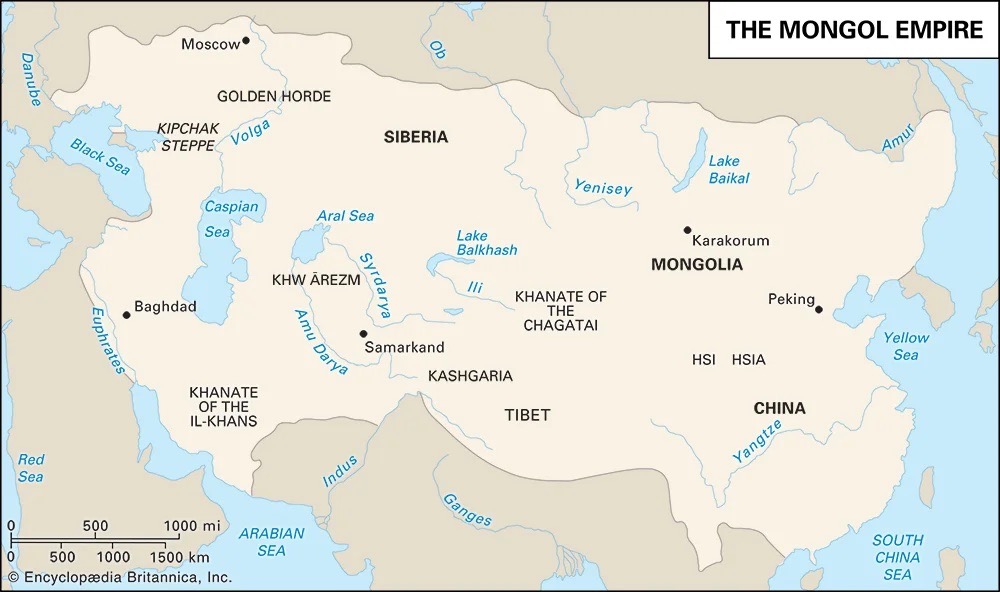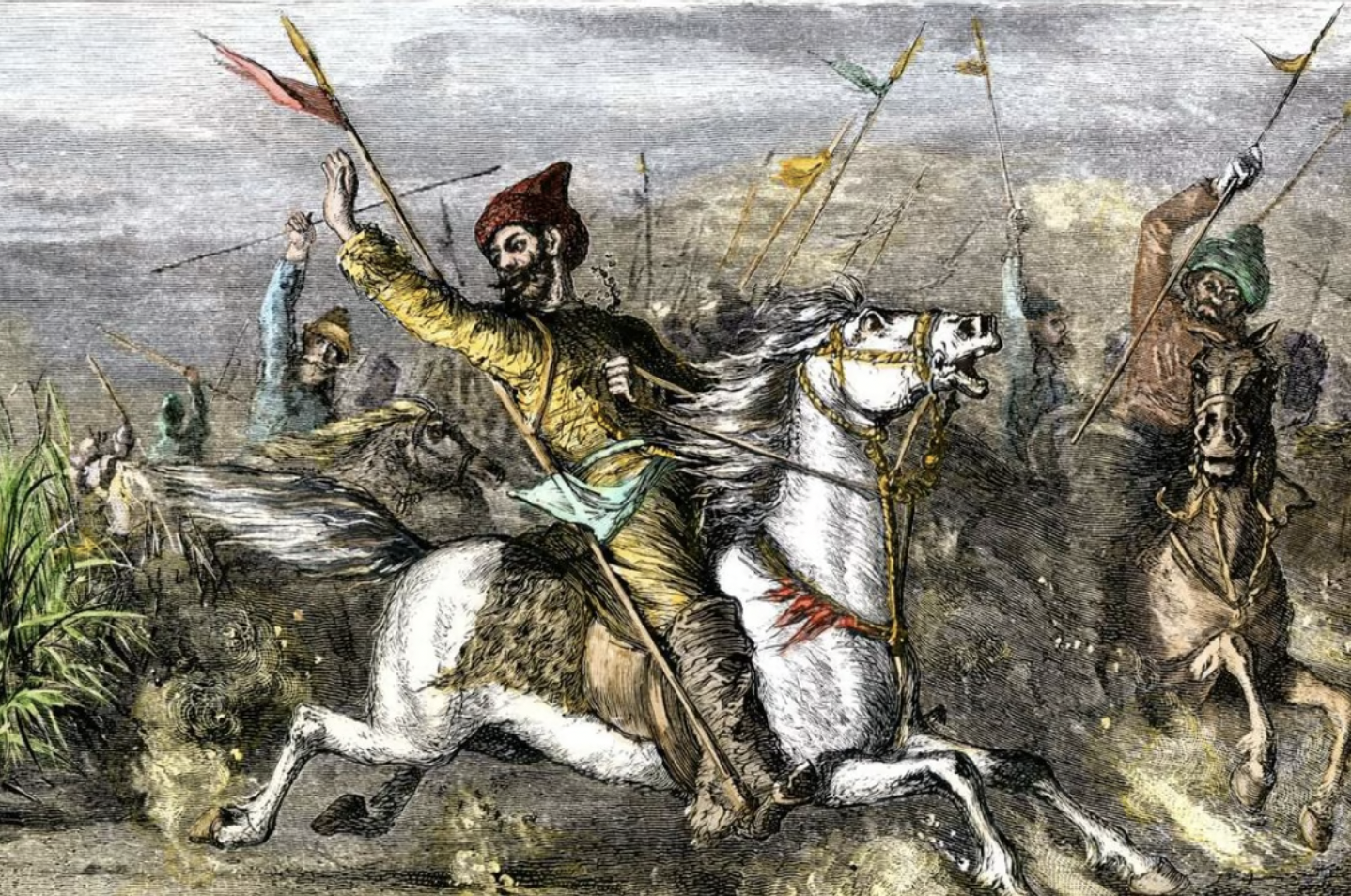What happened?
- The Mongols were pastoral nomads who resided in small tribes throughout the East Asian steppes. Each of these tribes was led by a leader or Khan, and they often clashed. The Mongols shepherded cattle, sheep, yaks, and camels between seasonal campsites.
- Established by Genghis Khan in 1206, the Mongol Empire was the largest contiguous empire in recorded history (image below). At its height, the Mongol Empire ranged from the Danube River (modern-day Hungary) to the Yellow Sea (modern-day China).

Map of the extent of the Mongol Empire at its height in the late 13th century. The Mongol empire covered over 23 million square kilometers (9 million square miles) from modern-day Hungary to the west and China to the east (from Editors of Encyclopaedia Britannica, 2023).
-
- Genghis Khan, formerly known as Temujin, unified nomadic Mongol and Turkic groups under his leadership in the early 13th century. Soon after, the Mongols captured Northern China and Siberia.
- Genghis Khan employed several military and political strategies that contributed to the success of his empire. He promoted his soldiers based on merit, distributed loot equally, and assimilated people from conquered groups into his ranks.
- The Mongol Empire was led by the Golden Lineage, Genghis Khan’s children, after his death in 1227. They went on to conquer the rest of Central Asia, parts of Russia and Europe, and southern China over the next fifty years.
- Following a period of relative unity in the Mongol Empire, the regime was fractured over leadership skirmishes. Years after his passing, Genghis Khan’s grandchildren fought for inheritance and split the Mongol Empire into four parts. The Mongol Empire officially ended in the 14th century.
- Genghis Khan, formerly known as Temujin, unified nomadic Mongol and Turkic groups under his leadership in the early 13th century. Soon after, the Mongols captured Northern China and Siberia.
- The Mongol Empire promoted artistry, technological innovations, and trade throughout its dominion. After forcibly conquering a region, the Mongols sought to restore industries and centers of innovation under their rule. Artisans, traders, and engineers were often recruited and taken to various projects across the empire.
-
- Under Mongol rule, trade along the Silk Road flourished and travel became safer and faster. Astronomical observatories were constructed and weapons innovations were spread from China to the Near East.
- The Mongol Empire also inadvertently spread diseases from Asia to Europe, including the bubonic plague. A 2020 study concluded that Mongol soldiers and traders carried rats and fleas infected with the plague across the empire and beyond. As a result, the Mongol Empire was indirectly responsible for the spread of the Black Death.
-
How is this related to climate?
- A 2014 study attributed a period of elevated rainfall and mild weather to the rise of the Mongol Empire. The Mongols lived in the Central Asian steppes, a region that is typically cold and arid. A period of warmer and wetter weather fostered local vegetation, enabling the Mongols to raise more livestock for food and horses for warfare.
- By analyzing rings of thousand-year-old trees in Mongolia, researchers from Columbia University (New York City, U.S.) were able to recreate climate conditions as far back as the rise of the Mongol Empire. From 1180 to 1190, the Central Asian steppes suffered an intense drought. Between 1211 and 1225, the region saw considerably more precipitation and warmer temperatures.
- A 2022 study of lake sediments from Central Mongolia supported these climate trends, adding that the period of increased humidity in the early 13th century weakened solar radiation. Decreased solar energy during summer months weakened the Asian monsoon system, bringing moisture north to the normally arid Central Asian steppes.
- Researchers attribute the drought of the 1180s to Genghis Khan’s rise to power amongst Mongolian nomadic tribes. The declining weather conditions may have limited resources, displaced nomads, and created a political situation that favored a supreme leader. Historians speculate that under these harsh conditions, Mongols accepted Genghis Khan as such a centralized ruler.
- Genghis Khan began his conquest outside of the Central Asian steppes in 1206, but his military expansion accelerated in the 1210s and 1220s, coinciding with increased precipitation and mild winters. The Mongolian plains at this time were likely very fertile and able to support many horses. This was crucial to the expansion of the Mongol Empire as Mongol soldiers were skilled horse riders and archers (image below). A combination of mobility and ranged attacks gave Mongols the advantage in battle.
- By analyzing rings of thousand-year-old trees in Mongolia, researchers from Columbia University (New York City, U.S.) were able to recreate climate conditions as far back as the rise of the Mongol Empire. From 1180 to 1190, the Central Asian steppes suffered an intense drought. Between 1211 and 1225, the region saw considerably more precipitation and warmer temperatures.

Artistic depiction of Genghis Khan riding a horse into battle (from Plester, 2012). Warm and wet climate conditions in the Central Asian steppes between 1211 and 1225 lead to an increase in vegetation which supported horses used by Mongol armies in their conquest of Eurasia.
References and additional resources
- Cartwright, M. “Mongol Warfare.” World History Encyclopedia. October 2019. https://www.worldhistory.org/Mongol_Warfare/.
- Di Cosmo, N. “Climate Change and the Rise of an Empire.” Institute for Advanced Study. 2014. https://www.ias.edu/ideas/2014/dicosmo-mongol-climate.
- Editors of Encyclopaedia Britannica. “Mongol empire.” Encyclopaedia Britannica. March 2023. https://www.britannica.com/place/Mongol-empire.
- Kern, Z. Pow, S. Pinke, Z. Ferenczi, L. “Samalas and the Fall of the Mongol Empire: A volcanic eruption’s influence on the dissolution of history’s largest contiguous empire.” Harvard and Smithsonian Center for Astrophysics. April 2021. https://ui.adsabs.harvard.edu/abs/2021EGUGA..23.3460K/abstract.
- Newhall, C. Self, S. Robock, A. “Anticipating future Volcanic Explosivity Index (VEI) 7 eruptions and their chilling impacts.” GeoScienceWorld. February 2018. https://pubs.geoscienceworld.org/gsa/geosphere/article/14/2/572/529016/Anticipating-future-Volcanic-Explosivity-Index-VEI.
- “Mongol Empire Rode Wave of Mild Climate, Says Study.” Columbia University. March 2014. https://www.earth.columbia.edu/articles/view/3160.
- Morton, N. “5 Ways the Mongol Empire Promoted Innovation.” History.com. May 2023. https://www.history.com/news/mongol-empire-innovation.
- Plester, J. “Weatherwatch: Climate helped Genghis Khan create the Mongol empire.” The Guardian. September 2012. https://www.theguardian.com/news/2012/sep/23/weatherwatch-climate-ghengis-khan-mongolia.
- Struck, J. Bliedtner, M. Strobel, P. Taylor, W. Biskop, S. Plessen, B. Klaes, B. Bittner, L. Jamsranjav, B. Salazar, G. Szidat, S. Brenning, A. Bazarradnaa, E. Glaser, B. Zech, M. Zech, R. “Central Mongolian lake sediments reveal new insights on climate change and equestrian empires in the Eastern Steppes.” Scientific Reports. February 2022. https://www.nature.com/articles/s41598-022-06659-w.
- TED-Ed. “The rise and fall of the Mongol Empire – Anne F. Broadbridge.” Youtube. August 2019. https://www.youtube.com/watch?v=wUVvTqvjUaM.
- Zielinski, S. “Warm, Wet Times Spurred Medieval Mongol Rise.” Smithsonian Magazine. March 2014. https://www.smithsonianmag.com/science-nature/warm-wet-times-spurred-medieval-mongol-rise-180950030/.
